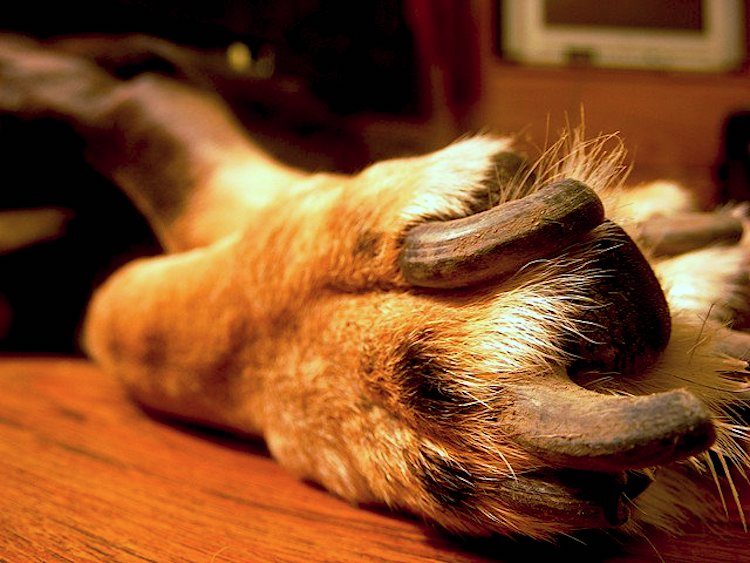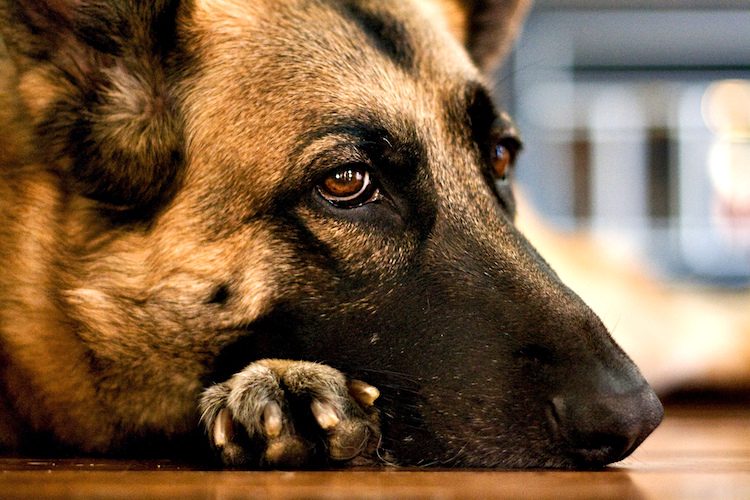
This pet health content was reviewed for accuracy by a veterinarian, Dr. Pippa Elliott, BVMS, MRCVS. This article was originally published in 2015 and is regularly reviewed for accuracy. It was last updated on June 12, 2024
If you have questions or concerns, call your vet, who is best equipped to ensure the health and well-being of your pet. This article is for informational purposes only and is not a substitute for professional medical advice, diagnosis, or treatment. See additional information.

Understanding and Preventing a Broken Dog Nail
At some point, your dog may tear, crack, or break a nail, particularly the dew claws. These nails, located higher up on the front of the foot, are more susceptible to damage as they are more loosely attached compared to regular nails.
Common Causes of a Broken Dog Nail:
- Nail Clipping: During nail trimming, even a slight jerk of the dog’s paw can cause a nail to break or chip. A strong pull can tear a nail partially or rip it out completely.
- Long Nails: Nails that are too long are more prone to snagging and tearing. They are also more likely to break or crack when a dog is walking or running on hard surfaces like asphalt or concrete.
- Weaker Nails: Some dogs are born with weaker nails, making them more vulnerable to damage.
Symptoms of a Damaged Nail
A damaged or broken dog nail can cause noticeable symptoms. Look out for the following signs:
- Favoring a paw by holding it in the air rather than walking on it.
- Limping or visibly not putting weight on a paw while walking.
- Blood on your dog’s bedding.
- Constant licking of a paw (learn more).
- A visibly swollen paw or toe.
- Resistance when you try to examine a paw or toe.
- Nail at an odd angle.
If your dog shows any of these symptoms, examine their paw if you feel comfortable doing so. However, if the toe is sore and injured, your dog might not allow you to touch their foot. In such cases, it’s time to go to a veterinarian.
If your dog allows you to examine the paw, consider using a muzzle (consider a muzzle) or having a helper divert your dog’s attention and mouth away from your hands during the examination.

5 Tips for Treating a Broken Dog Nail — Please Consult Your Vet First
If your dog has broken the nail down to the quick, you need to get to the vet’s office for proper treatment, possibly with your pet under sedation. It’s a painful injury.
Try the 5 tips below only if the nail wasn’t broken to the quick.
Tip 1: Safely Remove the Remaining Nail Piece
To prevent further injury and allow for proper healing and regrowth, carefully remove the dangling piece of the broken nail.
- Why Remove the Remaining Piece? Removing the remaining nail helps prevent additional injury and promotes proper healing.
- How to Do It: Some pet owners use pet nail clippers to cut off the dangling piece just above the break or tear. This can result in a clean cut that encourages proper nail regrowth.
- Caution: Dr. Pippa Elliott, BVMS, MRCVS, advises against this unless you are sure you won’t cut the quick, as it can be extremely painful and cause bleeding. It’s best done under sedation unless the crack is at the tip of a very long nail.
Tip 2: Stop the Bleeding
When removing the broken nail, your dog’s toe may bleed, especially if the break is near the quick.
- Why Stop the Bleeding? Stopping the bleeding is crucial to prevent excessive blood loss and to promote healing.
- How to Do It:
- Make sure you have your pet emergency kit ready.
- Apply a styptic pencil or powder to the wound to stop the bleeding almost immediately. These products contain a cauterizing agent that seals the wound.
- If you don’t have a styptic pencil or powder, use regular flour or cornstarch. Apply it to the wound and compress it with a towel for a few minutes until the bleeding stops.
By effectively stopping the bleeding, you can help your dog feel more comfortable and begin the healing process.
Tip 3: Clean and Disinfect the Wound
Keeping the wound clean is essential to prevent infection in your dog’s broken nail.
- Why Clean and Disinfect? Proper cleaning and disinfection prevent infections and promote faster healing.
- How to Do It:
- Bathe the paw in warm water to ensure all traces of dirt and debris are gone.
- Spray a pet antiseptic on the toe to disinfect the area and relieve any discomfort from the open wound.
- If the wound bleeds again, apply pressure or use a styptic pencil or powder.
Tip 4: Bandage the Paw
Bandaging your dog’s paw can be challenging, but it’s necessary to protect the wound and promote healing.
- Why Bandage the Paw? Bandaging protects the wound from dirt and further injury while allowing it to heal.
- How to Do It:
- Wrap the paw in a loose-fitting bandage, using first-aid tape to hold it in place.
- Alternatively, place a clean sock on the paw and tape it into place. A sock is often less restrictive than a regular bandage, making it more likely your dog will keep it on.
- If your dog pulls the bandage or sock off, consider using a plastic cone (Elizabethan collar or “E collar”) around their neck for a few days until the wound heals.
This approach helps ensure your dog’s paw remains clean and protected, facilitating quicker healing.
Tip 5: Change the Bandage Daily and Keep the Area Clean
Regularly changing the bandage is crucial to monitor the healing process and maintain cleanliness.
- Why Change the Bandage? Daily bandage changes help keep the wound clean and allow you to monitor the healing process.
- How to Do It:
- Change the bandage or sock once daily.
- Remove the bandage and bathe the paw in warm water.
- Check the paw for signs of infection:
- Swelling of the toe
- Oozing pus discharge
- Bleeding that may or may not be mixed with pus
- What to Do If You See Signs of Infection: If you notice any signs of infection, take your dog to the vet immediately. The vet will likely prescribe antibiotics to clear up the infection.
- Continued Care: If the wound is healing as it should, place a new bandage or sock on the paw. After 2–3 days, the wound should be healed enough that your dog will not lick it, and the E collar can be removed.
Always follow your vet’s instructions precisely to ensure your dog’s wound heals properly.
In this video, Dr. Candy Olson, DVM, explains more about a dog’s broken nail:
Treating a Broken Dew Claw on a Dog
Treating a broken dew claw requires specific care, and in some cases, your veterinarian may recommend the complete removal of both dew claws if one is injured.
- Why Dew Claw Removal? This procedure is common for certain breeds and ensures that further injuries are prevented.
- Aftercare: Once the dew claws are removed and the area has healed, your dog will be able to run and walk just as before without any issues.
This approach helps in managing dew claw injuries effectively, ensuring your dog recovers fully and remains active.
Frequently Asked Questions (FAQ)
How to fix a broken dog nail?
To fix a broken dog nail, carefully remove the dangling piece, stop the bleeding, clean the wound, bandage the paw, and monitor for infection.
How to bandage a dog’s paw for a broken nail?
To bandage a dog’s paw for a broken nail, wrap the paw in a loose-fitting bandage or a clean sock, and secure it with first-aid tape.
References
- Buzhardt, Lynn, DVM. “First Aid for Broken Nails in Dogs.” VCA Hospitals. 2015. https://vcahospitals.com/know-your-pet/first-aid-for-broken-nails-in-dogs.
- Eldredge, Debra M., DVM. Dog Owner’s Home Veterinary Handbook, 4th Edition. Howell Book House. 2007.
- Redding, Richard W., DVM, MSc, PhD, and Myrna L. Papurt, DVM. The Dog’s Drugstore. MacMillan. 2001. 197–98.
- Tedaldi, Jake, DVM. What’s Wrong With My Dog? Fair Winds Press. 2007. 80–81.



